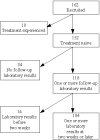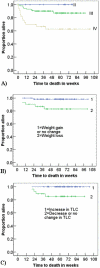Predictors of early death in a cohort of Ethiopian patients treated with HAART
- PMID: 16948852
- PMCID: PMC1569839
- DOI: 10.1186/1471-2334-6-136
Predictors of early death in a cohort of Ethiopian patients treated with HAART
Abstract
Background: HAART has improved the survival of HIV infected patients. However, compared to patients in high-income countries, patients in resource-poor countries have higher mortality rates. Our objective was to identify independent risk factors for death in Ethiopian patients treated with HAART.
Methods: In a district hospital in Ethiopia, we treated adult HIV infected patients with HAART based on clinical and total lymphocyte count (TLC) criteria. We measured body weight and complete blood cell count at baseline, 4 weeks later, then repeated weight every month and complete blood cell count every 12 weeks. Time to death was the main outcome variable. We used the Kaplan Meier and Cox regression survival analyses to identify prognostic markers. Also, we calculated mortality rates for the different phases of the follow-up.
Results: Out of 162 recruited, 152 treatment-naïve patients contributed 144.1 person-years of observation (PYO). 86 (57%) of them were men and their median age was 32 years. 24 patients died, making the overall mortality rate 16.7 per 100 PYO. The highest death rate occurred in the first month of treatment. Compared to the first month, mortality declined by 9-fold after the 18th week of follow-up. Being in WHO clinical stage IV and having TLC< or = 750/mcL were independent predictors of death. Haemoglobin (HGB) < or = 10 g/dl and TLC<= 1200/mcL at baseline were not associated with increased mortality. Body mass index (BMI) < or = 18.5 kg/m2 at baseline was associated with death in univariate analysis. Weight loss was seen in about a third of patients who survived up to the fourth week, and it was associated with increased death. Decline in TLC, HGB and BMI was associated with death in univariate analysis only.
Conclusion: The high mortality rate seen in this cohort was associated with advanced disease stage and very low TLC at presentation. Patients should be identified and treated before they progress to advanced stages. The underlying causes for early death in patients presenting at late stages should be investigated.
Figures


Similar articles
-
Predictors of early mortality in a cohort of HIV-infected children receiving high active antiretroviral treatment in public hospitals in Ethiopia.AIDS Care. 2015;27(6):723-30. doi: 10.1080/09540121.2014.997180. Epub 2015 Jan 19. AIDS Care. 2015. PMID: 25599414
-
Mortality and its predictors among highly active antiretroviral therapy naive hiv-infected individuals: data from prospective cohort study in Ukraine.Georgian Med News. 2014 Jul-Aug;(232-233):69-74. Georgian Med News. 2014. PMID: 25214276
-
Predictors of mortality among HIV-infected children receiving highly active antiretroviral therapy.Med Mal Infect. 2017 Feb;47(1):32-37. doi: 10.1016/j.medmal.2016.07.003. Epub 2016 Sep 5. Med Mal Infect. 2017. PMID: 27609595
-
Study of the impact of HIV genotypic drug resistance testing on therapy efficacy.Verh K Acad Geneeskd Belg. 2001;63(5):447-73. Verh K Acad Geneeskd Belg. 2001. PMID: 11813503 Review.
-
Highly active antiretroviral therapy is necessary but not sufficient. A systematic review and meta-analysis of mortality incidence rates and predictors among HIV-infected adults receiving treatment in Ethiopia, a surrogate study for resource-poor settings.BMC Public Health. 2024 Jun 28;24(1):1735. doi: 10.1186/s12889-024-19268-1. BMC Public Health. 2024. PMID: 38943123 Free PMC article.
Cited by
-
Association of pre-treatment nutritional status with change in CD4 count after antiretroviral therapy at 6, 12, and 24 months in Rwandan women.PLoS One. 2011;6(12):e29625. doi: 10.1371/journal.pone.0029625. Epub 2011 Dec 28. PLoS One. 2011. PMID: 22216334 Free PMC article.
-
Patients present earlier and survival has improved, but pre-ART attrition is high in a six-year HIV cohort data from Ethiopia.PLoS One. 2010 Oct 11;5(10):e13268. doi: 10.1371/journal.pone.0013268. PLoS One. 2010. PMID: 20949010 Free PMC article.
-
Correcting for mortality among patients lost to follow up on antiretroviral therapy in South Africa: a cohort analysis.PLoS One. 2011 Feb 17;6(2):e14684. doi: 10.1371/journal.pone.0014684. PLoS One. 2011. PMID: 21379378 Free PMC article.
-
Characteristics and predictors of death among hospitalized HIV-infected patients in a low HIV prevalence country: Bangladesh.PLoS One. 2014 Dec 8;9(12):e113095. doi: 10.1371/journal.pone.0113095. eCollection 2014. PLoS One. 2014. PMID: 25485634 Free PMC article.
-
Predictors of Survival among Adult Ethiopian Patients in the National ART Program at Seven University Teaching Hospitals: A Prospective Cohort Study.Ethiop J Health Sci. 2017 Feb;27(Suppl 1):63-71. doi: 10.4314/ejhs.v27i1.7s. Ethiop J Health Sci. 2017. PMID: 28465654 Free PMC article.
References
-
- Laurent C, Ngom Gueye NF, Ndour CT, Gueye PM, Diouf M, Diakhate N, Toure Kane NC, Laniece I, Ndir A, Vergne L, Ndoye I, Mboup S, Sow PS, Delaporte E. Long-term benefits of highly active antiretroviral therapy in Senegalese HIV-1-infected adults. J Acquir Immune Defic Syndr. 2005;38:14–17. doi: 10.1097/00126334-200501010-00003. - DOI - PubMed
-
- Braitstein P, Brinkhof MW, Dabis F, Schechter M, Boulle A, Miotti P, Wood R, Laurent C, Sprinz E, Seyler C, Bangsberg DR, Balestre E, Sterne JA, May M, Egger M. Mortality of HIV-1-infected patients in the first year of antiretroviral therapy: comparison between low-income and high-income countries. Lancet. 2006;367:817–824. doi: 10.1016/S0140-6736(06)68337-2. - DOI - PubMed
-
- Colebunders R, Moses KR, Laurence J, Shihab HM, Semitala F, Lutwama F, Bakeera-Kitaka S, Lynen L, Spacek L, Reynolds SJ, Quinn TC, Viner B, Mayanja-Kizza H. A new model to monitor the virological efficacy of antiretroviral treatment in resource-poor countries. Lancet Infect Dis. 2006;6:53–59. doi: 10.1016/S1473-3099(05)70327-3. - DOI - PubMed
MeSH terms
LinkOut - more resources
Full Text Sources
Medical

